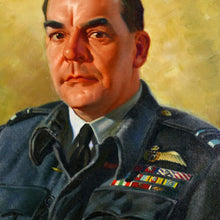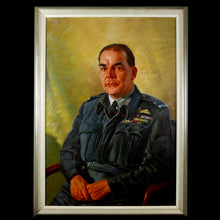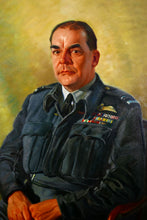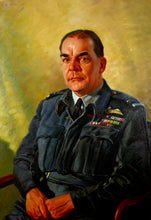Portrait of AVM Harry Broadhurst - Leonard Harry Wells, 1945
- Regular price
- £4,800
- Sale price
- £4,800
- Regular price
-
- Unit price
- /per
Adding product to your cart
Overall: 107cm (42in) x 77.5cm (30.5in)
Oil on canvas. Half length seated looking forward in Second World War RAF battle dress. Signed and dated upper left ‘L.H. Wells / 45’.
The present portrait needs to be considered in relation to a companion portrait by Wells of Broadhurst’s subordinate ‘Johnnie’ Johnson, the RAF’s highest scoring fighter pilot of the Second World War, which recently appeared on the London art market. Johnson’s portrait, and almost certainly Broadhurst’s, was painted in battle scarred Lubeck, northern Germany in 1945; then the scene of recent heavy fighting involving the British 11th Armoured Division, shattered remnants of the Wehrmacht, confused Hitler Youth and fanatical SS, all muddied by the presence of civilians, displaced persons and concentration camp victims. Wells’s portraits of both airmen convey a quiet confidence of a job well done in reducing the Third Reich and mark the survival of two towering figures of the air war in North West Europe.
Johnson held Broadhurst in the highest regard and he wasn’t alone among fighter aces in doing so: ‘Harry Broadhurst did not understand the meaning of fear and the stickier the situation the better he liked it. We missed his leadership, his sparkling sense of fun and his companionship; above all, he was always one of us!’ So wrote W.W.G. Duncan Smith of the spring of 1942 when Leigh-Mallory grounded Broadhurst for fear of losing a valuable staff officer hell-bent on participating in operations. Broadhurst was then Station Commander at RAF Hornchurch and regularly led the Hornchurch squadrons on fighter sweeps and bomber escort missions over northern France, a role that was normally the preserve of Honchurch’s wing leader.
Read more
On 25 February 1941, while flying with the Hornchurch Wing, Broadhurst destroyed a Me109 and probably a second; on 5 March he was credited with one probable and one damaged; in early June he destroyed one and damaged another, on the 21st destroyed two, on the 24th damaged two more, on the 25th probably destroyed another two, on 3rd July shot one down and probably a second. On 4 July 1941, he had a narrow escape when leading 54 Squadron, he was involved in a number of skirmishes with Bf109's, downing two when he himself was hit and his aircraft badly damaged. Recovering from a spin at 1000ft he decided to attempt the flight home but over Cap Griz Nez he was hit again, this time by flak. He nevertheless managed to coax his Spitfire across the Channel and crash landed back at Hornchurch.
Broadhurst was a pre-war regular with staff course training, and a three time winner of the annual Sassoon Trophy for air firing. In 1936 he had been personally congratulated for his skill as an aerobatics pilot by George VI and was awarded the Air Force Cross in 1937. He scored his first aerial victory in November 1939, when, taking off alone in foul weather, he shot down a Heinkel 111 into the North Sea (DFC, LG 1.1.1940). He fought in the Battle of France, having voluntarily dropped a rank in order to command a frontline squadron. Here he provided close air support to the ground forces, and became a firm believer in its importance in future operations. During the Battle of Britain he was station commander at RAF Wittering, Cambridgeshire and frequently flew sorties with both the day and night fighter units of the squadrons under his command, thus qualifying for the coveted Battle of Britain clasp.
Awarded the DSO in August 1941 and a bar in December (LG 4.7. & 19.12.1941), Broadhurst was selected to make a goodwill tour of the US with other high profile pilots. Upon his return he participated in Operation Fuller to intercept German battle cruisers Gneisenau and Scharnhorst and the heavy cruiser Prinz Eugen in the ‘Channel Dash’. The Hornchurch Wing was detailed to escort Lieutenant-Commander Eugene Esmonde’s 825 (Naval) Squadron’s obsolete Swordfish against the German ships. Broadhurst, anxious to get in the act, followed minutes after but never saw the Hornchurch Wing and headed, alone, towards Boulogne just below the 3,000-foot cloud base. There was nothing to be seen over the French coast so he headed to mid-Channel and, through broken cloud, caught glimpses of several E-boats heading towards Dunkirk. Later, at 6,000 feet, the he sighted a gaggle of Me109s, attacked ‘arse-end Charlie’ and shot him down into the Channel. Higher 109s came down on Broadhurst but he escaped into cloud and returned to Hornchurch to claim his victory.
In late 1942 he was posted to the Middle East and became Senior Air Staff Officer (SASO) to Air Vice-Marshal Arthur ‘Mary’ Coningham, the commander of the Desert Air Force (DAF). Broadhurst believed that Coningham was misusing the DAF, and, firmly believing in close cooperation with ground forces, won the confidence of Montgomery. He succeeded the Coningham in command in January 1943 and became the youngest Air-Vice-Marshal in the RAF. Broadhurst’s fresh outlook resulted in aerial cover unlike any seen before and won enduring gratitude of the men on the ground. Nevertheless, Broadhurst’s enthusiastic backing of the Army did not always go down well with senior airmen who did not subscribe to his commitment to close air support.
In March 1944 he was posted back to England during the build up for the invasion of France and with Montgomery’s backing was appointed Air Officer Commanding 83rd Composite Group, which, comprising twenty-nine fighter, ground-attack and reconnaissance squadrons and four artillery observation squadrons, grouped into ten wings, was to provide direct tactical air support for the Second British Army under the command of General Miles Dempsey. To this end Broadhurst developed a system of armoured ‘contact cars’ to push forward with the most advanced elements of the advancing troops, and a ‘cab rank’ system of circling aircraft tht could be called in at short notice to attack specific targets. In order to keep in touch with his widely dispersed squadrons and keep abreast of the ever-changing battle front, Broadhurst made good use of a German Fieseler Storch captured in North Africa that was capable of landing and taking off in a much shorter distances than any contemporary Allied aircraft. He was often seen over the Normandy beachhead in the Storch and beyond carrying a VIP passenger, which one notable occasion included the Prime Minister.

After pounding the fleeing German troops in the Falaise Pocket in August, Broadhurst’s 83 Group defended the Allied troops left in the Nijmegen bridgehead after the failure at Arnhem in September. In early 1945 Broadurst ran a programme of interdiction beyond the Rhine in the enemy's rear areas making unnumbered assaults on German road and railway traffic as well as bombing the Siegfried Line. Enemy losses rose to a new height but so to did those of 83 Group, with the enemy spreading his anti-aircraft defence more widely, and with the Luftwaffe putting in a late appearance, bolstered by their new jet fighter the Messerschmitt 262. At the crossing of the Rhine (Operation Varsity) 83 Group attacked all enemy airfields within fighter range of the bridgehead, and covered the 6th Airborne Division’s landing, whilst provided close support work by the use 'contact cars' with Twenty-First Army Group.
On 10 April 1945, Broadhurst, always in close touch with Dempsey, set up his headquarters at Mettingen, near Osnabrück, and two days later his Group was operating from four bases east of the Rhine and two west of it. The end was in sight. Nevertheless during the last fortnight of April, No. 83 Group was still called upon frequently to help the army, usually by means of attacks on fortified villages with bombs and rockets. On 20 April 1945, Broadhurst’s fighter pilots had a stroke of luck and shot down eighteen Messerschmitt 109's and Focke-Wulf 190's in the act of taking off from an airfield near Hagenau. Altogether that day the Group destroyed thirty-nine of the enemy for the loss of seven of their own aircraft, thus bringing the number of German aircraft of which they claimed the destruction, to more than 1,000 since D-Day on 6 June, 1944.
Having passed the Elbe, the British Second Army moved towards Lübeck, and the 6th Airborne Division made contact with the Russians at Wismar on the Baltic.
The final chapter of Broadhurst’s war played out on 3 May when Dönitz, who had succeeded Hitler on 30 April, sent emissaries to Montgomery's headquarters on Lüneburg Heath, and 83 Group sank thirteen vessels and damaged one hundred and one in Bay of Lübeck. It was believed these ships were crammed with German troops and Nazi officials hoping to escape and continue the struggle.
After the war, Broadhurst remained in the RAF and rose to the rank of Air Chief Marshal, retiring in 1976 after a career spanning fifty years. Along the way he was Commander-in-Chief of Bomber Command and in 1959 commanded NATO’s Allied Air Forces Central Europe. Air Chief Marshal Sir Harry Broadhurst died in 1995.
Ref: Sarkar, Dilip. Johnnie Johnson's Great Adventure: The Spitfire Ace of Ace's Last Look Back (p. 114). Pen & Sword Books. Kindle Edition.








